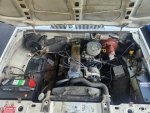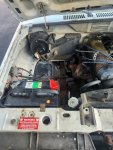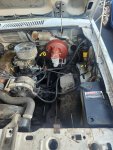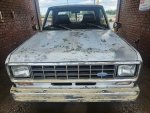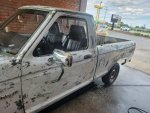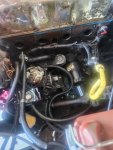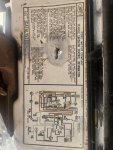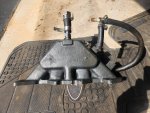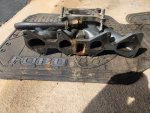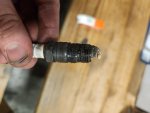Hello, I'm trying my hand at my first project vehicle and I'm in need of some help. I have a 1984 ford ranger RWD 4 speed manual with a 2.0ltr lima carb engine. I'm not trying to do anything real fancy with it. Mostly wanting to restore it and making it a good work truck to drive around and maybe haul nothing crazy. Thing is, I'm concerned about the engine. It's ford tough and was still running on corroded sparkplug and I believe on one cylinder. Seems like the engine has some moisture in it. The intake manifold is from a boat and the bores didn't line up. To make the carb fit, the guy dented the valve cap cover so the throttle could rest at idle. Ie. The manifold not only didn't fit, but was too short. The head is evenly spaced o shaped. Some day I do plan to rebuild the engine but for now I just want to get it running right/better. Finding an intake seems next to impossible. Closes being a 2.3 Offenhauser Oval Intake manifold. Its my understanding that the bore holes should match. A part of me thought about switching to EFI, one reason being it looks nicer/cleaner, but seems more complicated and expensive. Does anyone have any suggestions on what i should do or what else I should look for?
-
 Welcome Visitor! Please take a few seconds and Register
for our forum. Even if you don't want to post, you can still 'Like' and react to posts.
Welcome Visitor! Please take a few seconds and Register
for our forum. Even if you don't want to post, you can still 'Like' and react to posts. 
You are using an out of date browser. It may not display this or other websites correctly.
You should upgrade or use an alternative browser.
You should upgrade or use an alternative browser.
2.0L ('83-'88) 1984 ford ranger 2.0ltr lima carb or EFI? - intake manifold?
- Thread starter Nevermore
- Start date
- Joined
- Feb 28, 2001
- Messages
- 9,749
- Points
- 5,101
- City
- Dayton
- State - Country
- OR - USA
- Vehicle Year
- 1990, 1997
- Drive
- 4WD
- Engine
- 2.3 (4 Cylinder)
- Transmission
- Manual
- Total Lift
- 6
- Tire Size
- 35"
There's several different intake patterns for the Lima's from the '80's, I think all of the carb ones are the same then the single plug fuel injection is another pattern then the dual plug injected is another pattern... I think there's another mixed in for good measure possibly.
There was a marine manifold for one of the injected heads which is pretty sought after but I don't know much about that... All 2.0L's were carbed so assuming it's the stock head you're probably stuck on a carb setup unless you get some FI 2.3L stuff, and by that point you'd be better off switching to the rest of the 2.3L stuff...
If what you have works unless it's too janky I'd be tempted to just stay with it, maybe get a carb spacer to space the carb up like 1/2" which might help the clearance issues you're talking about.
There was a marine manifold for one of the injected heads which is pretty sought after but I don't know much about that... All 2.0L's were carbed so assuming it's the stock head you're probably stuck on a carb setup unless you get some FI 2.3L stuff, and by that point you'd be better off switching to the rest of the 2.3L stuff...
If what you have works unless it's too janky I'd be tempted to just stay with it, maybe get a carb spacer to space the carb up like 1/2" which might help the clearance issues you're talking about.
- Joined
- Aug 6, 2007
- Messages
- 5,494
- Points
- 2,001
- State - Country
- GA - USA
- Vehicle Year
- 1999
- Vehicle
- Ford Ranger
- Engine
- 5.0
- Transmission
- Automatic
- Total Drop
- few inches
- Tire Size
- ~30"
No real suggestions. All 2.0Ls were carbureted, only the 2.3L got EFI (except maybe 83-84). Can't say for certain, but I think you should be able to use any 2.3L intake manifold. Check out places like Racer Walsh, Esslinger Engineering, maybe Speedway Motors. All of them used to do a lot with the Limas, though they were geared more towards the larger 2.3L.
Truthfully I think you should be ok with the larger bore holes of the replacement intake manifold. Smaller head ports will create a bit of a wall there reducing power/performance, but you aren't making a large amount of power anyway. Your engine wasn't making enough power to begin with for it to be a major loss. If there's a large discrepancy between the intake a head ports, you could probably gasket match to clean it up. Personally if you try this, I'd only gasket match the head side. The 2.0L heads aren't very dersireable, but an unmolested intake manifold may be sought after as mentioned by Scott. If necessary, space the carb up like he mentioned to give proper clearance for other components.
Offenhauser does/did offer an intake manifold for the 2.0L round port. P/N is 6001-DP for 2bbl or 6000-DP for 4bbl (probably what RW sold in kit). Per an old Offenhauser catalog the 6001-DP is setup for a "Holley 5200 or stock 2 stage 2bbl carb." I definitely wouldn't recommend the 4bbl version for a stock 2.0L and not sure you could even find one available. I know nothing about any of those setups, just repeating what I've found in various places online. That said, I wouldn't do it unless you are dedicated to rebuilding that engine with stock cylinder head.
If the engine is going to need to be rebuilt anyway, I'd just focus on getting it running as good as possible with what you've got. For the rebuild see about picking up a 2.3L to start with and go from there. More parts/support available and more power in the same package. If you want to get a performance carb manifold, get it for that engine along with a camshaft and some other goodies. On the 2.3L I'm pretty sure you can also get a carb adapter plate for the EFI manifold, but I'm not sure what people do about the injector ports when they do that.
Truthfully I think you should be ok with the larger bore holes of the replacement intake manifold. Smaller head ports will create a bit of a wall there reducing power/performance, but you aren't making a large amount of power anyway. Your engine wasn't making enough power to begin with for it to be a major loss. If there's a large discrepancy between the intake a head ports, you could probably gasket match to clean it up. Personally if you try this, I'd only gasket match the head side. The 2.0L heads aren't very dersireable, but an unmolested intake manifold may be sought after as mentioned by Scott. If necessary, space the carb up like he mentioned to give proper clearance for other components.
Offenhauser does/did offer an intake manifold for the 2.0L round port. P/N is 6001-DP for 2bbl or 6000-DP for 4bbl (probably what RW sold in kit). Per an old Offenhauser catalog the 6001-DP is setup for a "Holley 5200 or stock 2 stage 2bbl carb." I definitely wouldn't recommend the 4bbl version for a stock 2.0L and not sure you could even find one available. I know nothing about any of those setups, just repeating what I've found in various places online. That said, I wouldn't do it unless you are dedicated to rebuilding that engine with stock cylinder head.
If the engine is going to need to be rebuilt anyway, I'd just focus on getting it running as good as possible with what you've got. For the rebuild see about picking up a 2.3L to start with and go from there. More parts/support available and more power in the same package. If you want to get a performance carb manifold, get it for that engine along with a camshaft and some other goodies. On the 2.3L I'm pretty sure you can also get a carb adapter plate for the EFI manifold, but I'm not sure what people do about the injector ports when they do that.
- Joined
- Aug 6, 2007
- Messages
- 5,494
- Points
- 2,001
- State - Country
- GA - USA
- Vehicle Year
- 1999
- Vehicle
- Ford Ranger
- Engine
- 5.0
- Transmission
- Automatic
- Total Drop
- few inches
- Tire Size
- ~30"
If you've got time and a decent camera (most cellphones) post up some good pictures of the components that he installed. We all like to see pictures, and maybe someone can identify the actual parts that the guy installed.
- Joined
- Feb 28, 2001
- Messages
- 9,749
- Points
- 5,101
- City
- Dayton
- State - Country
- OR - USA
- Vehicle Year
- 1990, 1997
- Drive
- 4WD
- Engine
- 2.3 (4 Cylinder)
- Transmission
- Manual
- Total Lift
- 6
- Tire Size
- 35"
Josh, '85 was the first year for fuel injection which is when the 2.3L switched but I think carb was still an option, 2.0L was offered in the US until '88 and until '89 in Canada but wasn't very popular since I think it only had like 68hp while the 2.3L had closer to 80...
- Joined
- Aug 6, 2007
- Messages
- 5,494
- Points
- 2,001
- State - Country
- GA - USA
- Vehicle Year
- 1999
- Vehicle
- Ford Ranger
- Engine
- 5.0
- Transmission
- Automatic
- Total Drop
- few inches
- Tire Size
- ~30"
Josh, '85 was the first year for fuel injection which is when the 2.3L switched but I think carb was still an option, 2.0L was offered in the US until '88 and until '89 in Canada but wasn't very popular since I think it only had like 68hp while the 2.3L had closer to 80...
Didn;t know if the 83-84 carb 2.3L was for all or some. You know how certain parts of the country will get special stuff for emissions purposes.
According to wiki it was 73 for the 2.0L. IMO it doesn't matter if it was 68 or 73, the power to weight ratio is so low that the few HP gained by matching the intake ports is unlikely to make an appreciable difference (can't speak for the offy and carb swap). Now if you can put in a 2.3L and bump the power closer to 100, that would be a worth while gain. Again, that's IMO, yours may be different.
- Joined
- Feb 28, 2001
- Messages
- 9,749
- Points
- 5,101
- City
- Dayton
- State - Country
- OR - USA
- Vehicle Year
- 1990, 1997
- Drive
- 4WD
- Engine
- 2.3 (4 Cylinder)
- Transmission
- Manual
- Total Lift
- 6
- Tire Size
- 35"
I was going of of memory but yeah, I knew it was silly low... the 2.3L was 90hp if memory serves in '89 and like 105 in '95 when it went sequential with smaller valve stems... I think the 2.5 got up to around 112...Didn;t know if the 83-84 carb 2.3L was for all or some. You know how certain parts of the country will get special stuff for emissions purposes.
According to wiki it was 73 for the 2.0L. IMO it doesn't matter if it was 68 or 73, the power to weight ratio is so low that the few HP gained by matching the intake ports is unlikely to make an appreciable difference (can't speak for the offy and carb swap). Now if you can put in a 2.3L and bump the power closer to 100, that would be a worth while gain. Again, that's IMO, yours may be different.
Ford never really even tried with the intake ports on the Lima platform, they're all restrictive, I lost like 4psi boost on my turbo engine when I ported the head so it's digesting way more air... and I didn't even know what I was doing, I mean I know the theory and goal but I wasn't aggressive or anything...
Here are some pics of the engine/head, plus some of the truck just to show. Most are all before I've done any work on it. I'm not worried about cosmetics rn. But yes, the manifold i took off the guy claimed was from a boat and the bores didn't line up in the slightest. I can double check how far off and add a spacer like you guys suggested. I did see a 2.3ltr manifold on FB market place but wasn't sure in what diection i should go with this engine, or how strick i should be with the head match issue. I even considered doing a full swap to a 302 v8. Yet i love rare things so i struggle with accepting defeat, lol. Give me some time and I can take a pic of the manifold I took off. As you can see, I'm missing quite a bit in the bay and what is there is a mess. No coolant lines to the engine so it's no surprise it blew a gasket and leaked oil. How invasive would i have to be swapping to a 2.3ltr? Would the tranny still line up or would I have to swap the gear box too? - I can work on aircrafts but vehicles are still a learning process for me. I appreciate you guys help.
Attachments
I should add that i did check out Racer Walsh, Esslinger Engineering, and Speedway Motors but they have been sold out for quite some time and don't answer phone calls. Every ranger i looked at in the salvage yards are v6's so it does seem the 2.0 is as rare as they come and might not be worth keeping just for the sole fact of part availability, now and in the future.
- Joined
- Aug 6, 2007
- Messages
- 5,494
- Points
- 2,001
- State - Country
- GA - USA
- Vehicle Year
- 1999
- Vehicle
- Ford Ranger
- Engine
- 5.0
- Transmission
- Automatic
- Total Drop
- few inches
- Tire Size
- ~30"
Here are some pics of the engine/head, plus some of the truck just to show. Most are all before I've done any work on it. I'm not worried about cosmetics rn. But yes, the manifold i took off the guy claimed was from a boat and the bores didn't line up in the slightest.
...
Give me some time and I can take a pic of the manifold I took off.
That would be better than whole engine pics. Unfortunately a Lima looks like a Lima. Unless it's got a big sign on the intake or valve cover (or EFI) most of us wouldn't know a 2.0L Lima engine from a 2.3L Lima engine on sight. Some might be able to identify parts with the engine disassembled, but I know I wouldn't except in a very broad sense.
You've shown the head ports, but the manifold was pretty hidden. Some more detailed pictures of it would probably help in identification and determining if there is a missmatch issue.
I even considered doing a full swap to a 302 v8. Yet i love rare things so i struggle with accepting defeat, lol.
I certainly won't discourage you from that. It's something that only you can decide. There are advantages to having a little 4 cylinder truck. You won't find a smaller, lighter 4 cylinder truck made in the last 30 years. Ok maybe an early Nissan or Mazda, but good luck finding on in decent shape (physically or mechanically) and as affordable.
As you can see, I'm missing quite a bit in the bay and what is there is a mess.
Maybe not. This was apparently a base model truck, not a lot of options. It didn't have EFI or AC, so there isn't really much more that would have been there from the factory. You're missing some coolant hoses to the heater cor, they've been looped and bypassed. Might be missing an airbox, not exactly sure what these had with the carburetor, but that aircleaner isn't stock. Maybe some emissions equipment removed, but the 2.0L might not have had that stuff to begin with.
Really, I can't see where you are missing very much. It was a very stripped down engine bay from the factory.
No coolant lines to the engine so it's no surprise it blew a gasket and leaked oil.
The coolant lines that matter appear to be there. You've got the ones going to the radiator. The heatercore is bypassed with those ports looped on the engine. That was probably done because the heater core, or a hose going to it, developed a leak and it was bypassed at the engine. A couple of caps would have worked just as well since coolant isn't required to flow through those ports, but hose and hose clamps were already available on the engine for bypassing. PO then decided he didn't need it enough to replace it.
Entirely possible that the leaking heater core caused it to run low on collant and blow a gasket, but bypassing the core itself would not cause that issue.
Fix your leaks/gaskets and carry on. If you want the heater back working, check your core for leaks and replace if necessary, then run new hoses from the engine to it and back. Word of advice, since that truck does not have AC. When you repair the heater core install a valve in one of the hoses to shutoff flow. Then you can close the valve in the warmer months when heat isn't needed and it might decrease the vent temps a little. I know that helps on the super duties that always have air blowing through the heater core (even in AC mode) and in stock form always have hot coolant flowing through it too. Cant recall how the Ranger's air path looks in various modes.
If you are staying with a carbed 2.3L is's basically the same removing and reinstalling the 2.0L. All mounts, acessory drive, transmission, etc are the same. That's not to say that there aren;ty better transmission options, but the 2.0L trans will bolt right up to the 2.3L and work. Get it swapped, then you can address if you wanted something better later.How invasive would i have to be swapping to a 2.3ltr? Would the tranny still line up or would I have to swap the gear box too? - I can work on aircrafts but vehicles are still a learning process for me.
Don't know what part of aviation maintenance you are in, but if are certified for and capable of working on an airplane, you are capable of working on a car or truck. I should know, there are a few aircraft maintainers around the forums and I'm one of them. I don't have the FAA certs for general and commercial aviation, but I went to tech school for it and was on military aircraft for 18 of the last 20 years. Hear lots of people say that they don't know cars, but for most its just because they aren't familiar with it. There may not be step by step technical data for removing a 2.0L and installing a 2.3L (or V8), but if you had the torque specs, general guidelines, and tools, you could figure it out. Modern vehicle may be much more complex than an old aircraft, but this Ranger isn't, and the work isn't near as critical since it stays close to the ground (hopefully).
- Joined
- Aug 6, 2007
- Messages
- 5,494
- Points
- 2,001
- State - Country
- GA - USA
- Vehicle Year
- 1999
- Vehicle
- Ford Ranger
- Engine
- 5.0
- Transmission
- Automatic
- Total Drop
- few inches
- Tire Size
- ~30"
Summit shows the 6001-DP available for the 2.0L, but I would not spend the money on it. Instead, I'd do the 2.3L swap and invest in parts for that. Cost more, buy I think you'd be happier with the results. From an unique or original standpoint, no one looking in the bay is going to know the difference between a carbed 2.0L and a carbed 2.3L unless there is a sign like mentioned previously.I should add that i did check out Racer Walsh, Esslinger Engineering, and Speedway Motors but they have been sold out for quite some time and don't answer phone calls. Every ranger i looked at in the salvage yards are v6's so it does seem the 2.0 is as rare as they come and might not be worth keeping just for the sole fact of part availability, now and in the future.
Numbers being 91312 and 912470. Am I to assume it's a 2ltr given it has a stand alone #2?
It does bolt up. However, the inner bores are more restricted given it makes a ( ) shape when comparing to the gasket that lines up with the head. I suppose that wouldn't matter as much since swapping to a 2.3ltr does seem more logical than trying to restore this 2.0 that will most likely cost the same if I'm being honest and are right about the moisture being in there. I've never seen a sparkplug look like this before.
It does bolt up. However, the inner bores are more restricted given it makes a ( ) shape when comparing to the gasket that lines up with the head. I suppose that wouldn't matter as much since swapping to a 2.3ltr does seem more logical than trying to restore this 2.0 that will most likely cost the same if I'm being honest and are right about the moisture being in there. I've never seen a sparkplug look like this before.
Attachments
- Joined
- Feb 28, 2001
- Messages
- 9,749
- Points
- 5,101
- City
- Dayton
- State - Country
- OR - USA
- Vehicle Year
- 1990, 1997
- Drive
- 4WD
- Engine
- 2.3 (4 Cylinder)
- Transmission
- Manual
- Total Lift
- 6
- Tire Size
- 35"
On that plug it's just some oil probably from rings or valve stem seals. I would not worry about that amount of gasket mismatch, that's nothing...
It was on all the spark plugs, but thats good to know. Like I said, I wasn't sure how stict or worried I should be about the bores lining up. So I'm glad I don't have to worry about it too much and can use what I have. Thank you all for your input. I appreciate the help getting a game plan together.

